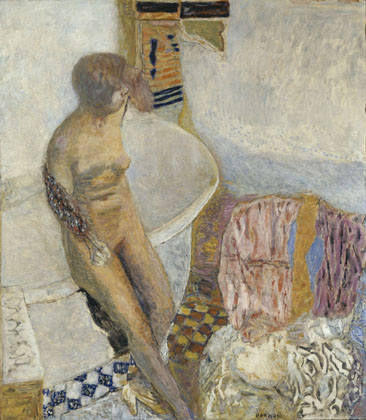Fr : version française / En: english version
mheu, Historical Museum of the Urban Environment
Nude at her bath
Pierre Bonnard

1931
oil on canvas
120cm x 110cm
Paris, Musée National d'Art Moderne - Centre Georges Pompidou
© ADAGP, Photo CNAC/MNAM, Dist. RMN / Adam Rzepka
View this work in the Bathing exhibition
The work
Like Degas, Bonnard painted a lot of nudes in the bath. Sometimes he even photographed them. This nude at her bath is probably of Marthe, the painter's companion, who died in 1942. Bonnard uses an original, almost cinematographic high-angle viewpoint. From this position, he can capture both the subtlety of the light on Marthe's skin and the tiles, the bathmat, the clothes draped over the chair, the louvered shutters - and the delicately color-tinted whites of the bathtub and curtain. Bonnard often used this elevated viewpoint. Without actually telling a story, this composition suggests that woman is somehow born out of the water - and sometimes even she is still merged with it, as if she has not yet learned how to differentiate herself. So the bathtub appears as a kind of original place, Plato's chora in which forms materialize, or space, the matrix of Derrida.
The artist
Pierre Bonnard, born in Fontenay-aux-Roses in 1867, was initially part of the Nabi group, along with Vuillard, Vallotton and Maurice Denis. He had met Vuillard at the Ecole des Beaux-Arts in Paris where he went in 1888 after obtaining a law degree. He was fond of Japanese art which gave him an unusual conception of space, with off-center arrangements, no perspective and rich decorative motifs. He became a lawyer in 1890 and spent his time drawing his fellow lawyers in court. In 1893 he met Marthe, who became his model and companion. In the early 20th century he traveled, to Italy, Spain, Belgium and Holland. On his return, his art gradually moved away from the Nabi and his palette lightened. He painted a lot of nudes and developed a passionate interest in the play of light on the body. When he met Monet in 1912, he tried his hand at landscapes but very quickly restricted the space to a garden, an interior or a bathroom, the intimate places where he could combine the play of light on the skin with decorative motifs - flowers, plants, tiles, drapes, etc. He retired to the south of France where he kept company with Matisse and died at Canet in 1947.